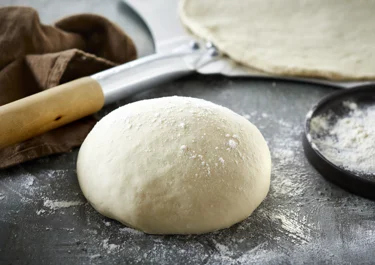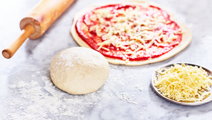
Pizza dough

Instructions
Tips
This recipe for pizza dough gives you one big pizza, but you can easily make two smaller ones instead. Divide the dough into 2 balls, press them flat, and stretch them until they have a diameter of 25 cm. If you wish to freeze the pizza bases, simply place a sheet of baking paper between them and put them into a big freezer bag. When you what to make pizzas, allow the pizza bases to thaw in the fridge and afterwards, let them rise for about 15 minutes on the kitchen counter before spreading the filling on top.
Tips
When working on the pizza dough, keep it warm and allow it enough time to rest. This will prevent holes and tears. In case it does happen, you can fix the holes or tears by pinching the dough together. You can even let it rest for 10 minutes after mixing all the ingredients and before the 8 minutes of kneading. This will make the flour absorb the flour and develop the gluten network, and in the end, make a better dough. Do not use a rolling pin to flatten and shape your pizza bases, as this method pushes out the gas created by the yeast, and you will end up with a dense and hard crust.
Questions about pizza dough
If you are looking for an easy pizza dough recipe, you have come to the right place. With our recipe, you can achieve an amazing base and a crispy crust for your pizza. Read below and find out how to make pizza dough from scratch, how to stretch pizza dough and much more.
Ingredients
Yeast | 10 g |
|---|---|
Lukewarm water | 150 ml |
Pizza flour, for example, Tipo 00 | 200 g |
Olive oil | ½ tbsp |
Sugar | ¼ tsp |
Coarse salt | ¼ tsp |
Easy homemade pizza dough
Making pizza dough from scratch is usually no easy feat, but it can be with our recipe for pizza dough that yields the best homemade pizza from start to finish. This recipe is super easy to throw together with only a few ingredients and simple steps. Skip the pizza delivery and learn how to make a crispy crust that turns out perfect every time. Spread your favourite filling on top and enjoy a delicious slice of homemade pizza.
Explore more amazing Italian-inspired recipes for bruschetta made with ripe tomatoes, garlic, oil and basil on top of toasted Italian bread, classic focaccia topped with rosemary, oil, and flaky salt, and for dessert a simple and soft vanilla-flavoured panna cotta with berry coulis.
Choose the best flour
The best type of flour to use for your pizza dough is Tipo 00, a finely ground Italian wheat flour. 00 flour is considered the golden standard for pizza flour and is traditionally used to make both pizza dough and pasta. Because the flour is so fine, it makes for a more responsive and elastic dough that will not tear as easily when shaped thin. The perfect combination of sturdy and delicate makes this flour perfect for creating delicious crispy pizza crusts with a slight but pleasant chew on the inside, as well as a nice open and airy structure.
Look at the protein level to find the best pizza flour. The higher the better and it should preferably not be less than 12 g of protein pr. 100 g. This will make for a stronger gluten structure, which will then make a more stretchable pizza.
What to make with pizza dough
You can easily make a classic Neapolitan margarita pizza with homemade tomato sauce, mozzarella, fresh basil, and virgin oil spread on top of the pizza base. However, pizza dough is very versatile, and it does not necessarily have to end with a pizza. There are so many different and equally delightful ways to enjoy the dough.
If you have any small scrap of dough left, use it to make crackers by rolling the dough really thin and brushing it with a thin layer of olive oil and sprinkle with salt. Bake the crackers for a few minutes and break them into smaller pieces after cooling. Similarly, you can roll the dough into long, skinny breadsticks and bake them until they are golden. It makes for a great snack that you can enjoy between meals.
Ever wanted to try an enclosed pizza? Make a calzone by spreading your filling on half of the pizza base and folding the other half over the filling. A big crispy, golden-brown pocket filled with melted cheese, sauce, and any filling of your choosing. There are endless possibilities with this pizza dough; give it a try!
Experiment with the recipe
The type of flour you choose ultimately depends on which pizza style you want to end up with. As each flour has its own characteristic traits, you can create different kinds of crusts for your pizza. For example, for a more textured crust, swap out about 50 g of the pizza flour with whole wheat flour, or use all-purpose flour to get a crispy crust. All-purpose flour is especially great when trying to achieve a thin pizza crust because the dough will not rise as high as when using other types of flour.
To obtain a thick and fluffy dough with crispy edges, try bread flour. This flour is very easy to work with and is often used to create a crispy crust while being slightly chewy on the inside. If you love a thin crust, use almond flour combined with buckwheat flour to add flavour and structure to the dough.










